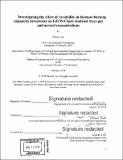| dc.contributor.advisor | Colette L. Heald. | en_US |
| dc.contributor.author | Su, Flora K. (Flora Kathleen) | en_US |
| dc.contributor.other | Massachusetts Institute of Technology. Department of Civil and Environmental Engineering. | en_US |
| dc.date.accessioned | 2018-05-23T16:34:42Z | |
| dc.date.available | 2018-05-23T16:34:42Z | |
| dc.date.copyright | 2018 | en_US |
| dc.date.issued | 2018 | en_US |
| dc.identifier.uri | http://hdl.handle.net/1721.1/115784 | |
| dc.description | Thesis: M. Eng., Massachusetts Institute of Technology, Department of Civil and Environmental Engineering, 2018. | en_US |
| dc.description | Cataloged from PDF version of thesis. | en_US |
| dc.description | Includes bibliographical references (pages 38-42). | en_US |
| dc.description.abstract | Over the past century, global wildfire activity has intensified due to increasing mean temperatures. However, emissions inventories used for modeling the impact of fires on air quality and climate exhibit several discrepancies in emissions estimates, largely due to the different types of satellite products used for identifying fires and measuring burned area, as well as differences in emission factors describing the vegetative fuels burned. Using the GEOS-Chem v1 1-01 chemical transport model, we studied how differences in emissions estimates between two commonly-used global biomass burning inventories, the Global Fire Emissions Database (GFED4) and the Fire INventory from NCAR (FINNy 1), affects modeled concentrations of carbon monoxide (CO), nitrogen oxide (NO), black carbon (BC) aerosol, and organic carbon (OC) aerosol. We find that biomass burning emissions significantly impacted concentrations of CO, BC, and OC over the U.S., and that the estimated seasonal impact of fires differed between the FINN and GFED inventories. Simulations using FINN predict higher fire emissions and consequently, a greater impact on springtime concentrations of CO (~10% higher than GFED), BC (~20% higher), and OC (-30% higher). GFED, on the other hand, attributes a greater contribution of fires to summertime emissions, with 60 to 90% of yearly fire emissions occurring during the summer months versus 35 to 70% as estimated by FINN. During years with intensive summer wildfires, simulations using GFED exhibited a higher contribution of fires from the Western U.S. and the Canadian Northwest Territories to total CO (30%), BC (50%), and OC (70%) concentrations across the Northern U.S. Simulations using FINN, which estimated higher emissions during the fall/winter, showed a much smaller contribution of summer fires to concentrations in the Northern U.S. (25% CO, 25% BC, 50% OC), but a higher contribution during the fall and winter (20% CO, 15 to 25% BC, 40 to 50% OC. This analysis thus shows that the choice of biomass burning emissions inventory can have a significant impact on the modeled impact of fires on atmospheric composition - FINN estimates a larger impact from smoldering fires, whereas GFED estimates a greater contribution from flaming combustion. | en_US |
| dc.description.statementofresponsibility | by Flora K. Su. | en_US |
| dc.format.extent | 66 pages | en_US |
| dc.language.iso | eng | en_US |
| dc.publisher | Massachusetts Institute of Technology | en_US |
| dc.rights | MIT theses are protected by copyright. They may be viewed, downloaded, or printed from this source but further reproduction or distribution in any format is prohibited without written permission. | en_US |
| dc.rights.uri | http://dspace.mit.edu/handle/1721.1/7582 | en_US |
| dc.subject | Civil and Environmental Engineering. | en_US |
| dc.title | Investigating the effect of variability in biomass burning emissions inventories on GEOS-Chem modeled trace gas and aerosol concentrations | en_US |
| dc.type | Thesis | en_US |
| dc.description.degree | M. Eng. | en_US |
| dc.contributor.department | Massachusetts Institute of Technology. Department of Civil and Environmental Engineering | |
| dc.identifier.oclc | 1036987800 | en_US |
